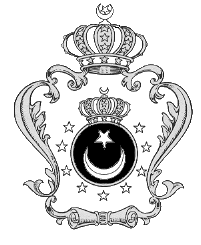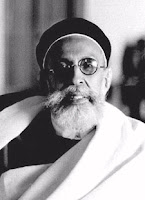Sunday Deposed Monarch Blogging: Senussi Dynasty
 The Senussi religious order was founded in 1837 as an antidote to what amounted to the perceived liberalization of Islam. It’s founder, Sayyid Muhammad ibn Ali as-Senussi, was born in Algeria but studied in Cairo, Mecca, and elsewhere in the Arab world. He attempted to return to Algeria around 1840 but was denied entry by the French. In response, he led the construction of a monastery in Cyrenaica, now part of Libya and then part of the Ottoman Empire. Gathering followers from across North Africa, Muhammad carved a de facto independent state out of the Ottoman desert territories.
The Senussi religious order was founded in 1837 as an antidote to what amounted to the perceived liberalization of Islam. It’s founder, Sayyid Muhammad ibn Ali as-Senussi, was born in Algeria but studied in Cairo, Mecca, and elsewhere in the Arab world. He attempted to return to Algeria around 1840 but was denied entry by the French. In response, he led the construction of a monastery in Cyrenaica, now part of Libya and then part of the Ottoman Empire. Gathering followers from across North Africa, Muhammad carved a de facto independent state out of the Ottoman desert territories.
 In 1911, Italy conquered Cyrenaica in the brief Italo-Ottoman War. In 1920, Italy granted Sayyid Muhammad Idris bin Sayyid Muhammad al-Mahdi al-Senussi, Sayyid Muhammad Ibn Ali as-Senussi’s grandson, the title of Emir of Cyrenaica. Two years later he was named Emir of neighboring Tripolitania. Idris’ efforts on behalf of independence were frowned on by the Italians, and he was driven into exile in the late 1920s. After struggling for independence through the 1930s, Idris followed General Bernard Montgomery and his army as they rolled up the German and Italian position in Libya in 1943. After several years of negotiations and protectorates, Libya was unified as an independent state in 1951, and Idris took the title of King Idris I.
In 1911, Italy conquered Cyrenaica in the brief Italo-Ottoman War. In 1920, Italy granted Sayyid Muhammad Idris bin Sayyid Muhammad al-Mahdi al-Senussi, Sayyid Muhammad Ibn Ali as-Senussi’s grandson, the title of Emir of Cyrenaica. Two years later he was named Emir of neighboring Tripolitania. Idris’ efforts on behalf of independence were frowned on by the Italians, and he was driven into exile in the late 1920s. After struggling for independence through the 1930s, Idris followed General Bernard Montgomery and his army as they rolled up the German and Italian position in Libya in 1943. After several years of negotiations and protectorates, Libya was unified as an independent state in 1951, and Idris took the title of King Idris I.
Idris maintained close relations with the West in spite of increasing tensions between the US, UK, and the Arab world. In 1969, the King’s poor health and failure to produce an heir left his domestic opponents with an opportunity. Because of health concerns, Idris I had decided to abdicate in favor of his nephew on September 2. A coup led by Colonel Muammar al-Gaddafi overthrew the King’s government on September 1, while the King was receiving medical treatment in Turkey. The King’s nephew, Sayyid Hassan As-Senussi, was placed under house arrest, along with most of the rest of the royal family. King Idris would live in exile in Greece and Egypt until his death in 1983.
 In 1984 Gaddafi released the royal family from house arrest and tossed them onto the street. The family lived for a period in a cabin on a public beach. Sayyid Hassan, suffering from poor health, was allowed to travel with most of the family to London for medical treatment, where they settled. Hassan died in 1992, and was succeeded as pretender King by his son, Sayyid Muhammad bin Sayyid Hasan ar-Rida al-Mahdi as-Senussi. Muhammad has been somewhat active in Libyan exile circles, participating in an anti-Gaddafi rally in London in 2005. Muhammad has made Libyan democracy his public cause, but has not renounced the throne. Prospects for a return to the throne are uncertain. The contours of Libyan politics are difficult to get a firm grasp on, due in no small part to the continuing dominance of Gaddafi. There is no strong evidence that substantial monarchist support exists in Libya, however, and it would seem that the fall of Gaddafi would more likely result in the establishment of a republic rather than a return to the monarchy.
In 1984 Gaddafi released the royal family from house arrest and tossed them onto the street. The family lived for a period in a cabin on a public beach. Sayyid Hassan, suffering from poor health, was allowed to travel with most of the family to London for medical treatment, where they settled. Hassan died in 1992, and was succeeded as pretender King by his son, Sayyid Muhammad bin Sayyid Hasan ar-Rida al-Mahdi as-Senussi. Muhammad has been somewhat active in Libyan exile circles, participating in an anti-Gaddafi rally in London in 2005. Muhammad has made Libyan democracy his public cause, but has not renounced the throne. Prospects for a return to the throne are uncertain. The contours of Libyan politics are difficult to get a firm grasp on, due in no small part to the continuing dominance of Gaddafi. There is no strong evidence that substantial monarchist support exists in Libya, however, and it would seem that the fall of Gaddafi would more likely result in the establishment of a republic rather than a return to the monarchy.
Trivia: Which monarch’s last serious bid for the throne ended when his proxy war patron withdrew its support in 1970?


